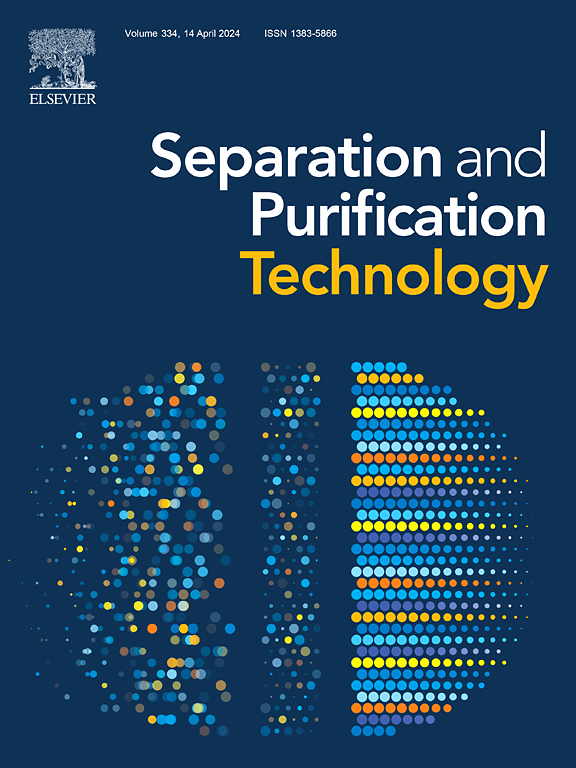钠基助剂煅烧提高污水焚烧污泥灰分作为钒石的磷回收率
IF 9
1区 工程技术
Q1 ENGINEERING, CHEMICAL
引用次数: 0
摘要
从焚烧污泥灰(ISSA)中回收磷(P)是一种很有前途的解决磷短缺问题的方法。提出了一种通过煅烧、水浸和结晶的方法从ISSA中提高磷的回收策略,以获得高附加值的活石。通过理论和实验方法考察了钠基添加剂(NaCl、NaOH、Na2CO3和NaHCO3)、煅烧温度(700 ~ 1000 °C)、添加剂用量和停留时间对P转化的影响。进一步评价了滤液再循环对橄榄石结晶的保水作用。结果表明,碱性钠基添加剂(NaOH、Na2CO3和NaHCO3)和焙烧温度的升高有利于磷灰石磷(AP)和非磷灰石无机磷(NAIP)转化为水溶性P (H2O-P)为Na3PO4。在1000 °C时,观察到AP转化为不溶于水的CaNaPO4。水磷占总磷(TP)的最高比例为90.53 %。在NaHCO3用量为50% %、800 °C、60 min条件下,ISSA的最佳P浸出率为90.12 %。富磷渗滤液经纯化结晶后,收集到的橄榄石产品具有典型的花状形态,实际铁磷摩尔比为1.40。滤液再循环对渗滤液磷回收率的影响可以忽略不计。该策略可使ISSA的总磷回收率达到78.03 %。本研究为从ISSA中提取P作为高附加值活石提供了一条有吸引力的途径。本文章由计算机程序翻译,如有差异,请以英文原文为准。


Enhanced phosphorus recovery from incinerated sewage sludge ash as vivianite through calcination with sodium-based additives
Phosphorus (P) recovery from Incinerated Sewage Sludge Ash (ISSA) is a promising way to alleviate P shortage concerns. An enhanced P recovery strategy from ISSA through calcination, water leaching, and crystallization was proposed to obtain high value-added vivianite. The influence of sodium-based additives (NaCl, NaOH, Na2CO3, and NaHCO3), calcination temperature (700∼1000 °C), additives dosage, and residence time on the P transformation was examined with theoretical and experimental approaches. The effect of filtrate recirculation on the vivianite crystallization was further assessed for water conservation. Results indicate that alkaline sodium-based additives (NaOH, Na2CO3, and NaHCO3) and elevated calcination temperature facilitate the conversion of apatite phosphorus (AP) and non-apatite inorganic phosphorus (NAIP) into water-soluble P (H2O-P) as Na3PO4. At 1000 °C, the conversion of AP to water-insoluble CaNaPO4 is observed. The highest proportion of H2O-P to total phosphorus (TP) of 90.53 % is yielded. The optimal P leaching rate from calcined ISSA reaches 90.12 % at 50 % NaHCO3 dosage, 800 °C, and 60 min. Following the purification and crystallization of P-rich leachate, the vivianite product is collected with a typical flower-like morphology and practical Fe/P molar ratio of 1.40. The influence of filtrate recirculation on the P recovery rate from the leachate is negligible. The proposed strategy can yield the highest total P recovery rate of 78.03 % from ISSA. This study provides an appealing way to recover P from ISSA as high value-added vivianite.
求助全文
通过发布文献求助,成功后即可免费获取论文全文。
去求助
来源期刊

Separation and Purification Technology
工程技术-工程:化工
CiteScore
14.00
自引率
12.80%
发文量
2347
审稿时长
43 days
期刊介绍:
Separation and Purification Technology is a premier journal committed to sharing innovative methods for separation and purification in chemical and environmental engineering, encompassing both homogeneous solutions and heterogeneous mixtures. Our scope includes the separation and/or purification of liquids, vapors, and gases, as well as carbon capture and separation techniques. However, it's important to note that methods solely intended for analytical purposes are not within the scope of the journal. Additionally, disciplines such as soil science, polymer science, and metallurgy fall outside the purview of Separation and Purification Technology. Join us in advancing the field of separation and purification methods for sustainable solutions in chemical and environmental engineering.
 求助内容:
求助内容: 应助结果提醒方式:
应助结果提醒方式:


